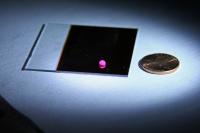Jun 18 2010
Purdue University researchers have created a tool that is based on a combination of electric and light fields and can be utilized for crime-scene forensics, testing water and food for contamination and medical diagnostics. These fields are used to position tiny particles and droplets like DNA, bacteria and viruses, which are enclosed in the drops.
 Purdue University This image shows a new hybrid optoelectric device developed by researchers at Purdue
Purdue University This image shows a new hybrid optoelectric device developed by researchers at Purdue
These droplets or particles can also be positioned by other techniques that use either electric or light fields. However, this novel hybrid optoelectric gadget is able to use both fields, rendering its practical utility in industrial processes and sensors, according to Aloke Kumar, a mechanical engineering doctoral student.
Such particles in the droplets are normally sensed when they fall on the surface of a sensor randomly. The new technique, however, can enhance the efficiency of the sensor through active movement of particles to particular locations on an electronic chip to facilitate analysis or detection.
This technique could lead to an innovative ‘lab-on-a-chip’ technology that could utilize electronic chips for analyzing biological samples for environmental as well as medical applications. Sensors that are developed by using this technique could help in the emergence of a new category of assays or chemical analyses, providing the hospitals or doctors’ offices with point-of-care devices.
These sensors will be able to analyze blood, urine, and various body fluids quickly for many applications like drug screening; sensing bacteria and infectious diseases, viruses and fungi that are not easy to culture using paternity testing; sensing tumors, coronary artery diseases, and various diseases that are inherited like cystic fibrosis; and conservative laboratory methods.
Indium tin oxide electrodes, made of an electrically conductive and transparent substance usually utilized in touch screen devices in consumer electronics, are critical to this technology. Liquid drops are placed on these electrodes. Electrodes and the droplets are then heated by the infrared laser. The heated droplets are forced by the electrodes’ electric fields to generate a microfluidic vortex of the revolving fluid. The vortex helps researchers to place the particles in the revolving liquid through the infrared laser’s movement. The particles gather at a place when the laser shines on them.